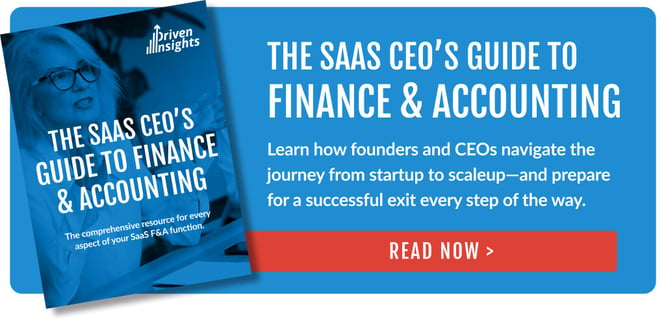
SaaS metrics are more than cookie-cutter formulas for tracking high-level KPIs. They are dynamic growth tools that should inform the decisions your leadership team, management, and board make on a routine basis. Used well by your SaaS business, they highlight trends, reveal opportunities, and keep everyone aligned on building enterprise value. Used poorly, however, SaaS metrics can paint an inaccurate picture of company health, undermine your growth efforts, and erode investor confidence. As such, the proper selection, calculation and interpretation of key SaaS metrics is critical for SaaS companies.
Along with financial statements that your team should be analyzing at the end of each month, SaaS metrics are a key component of the comprehensive reporting package your team should be analyzing, with the goal of turning all of that data into decisive action. But there’s a problem: SaaS metrics often mean different things to different people and many SaaS leadership teams are unknowingly basing key decisions on inconsistently and/or incorrectly calculated KPIs.
For example, there are multiple ways to calculate revenue churn. There are numerous ways to define ARR (Annual Recurring Revenue). There’s more than one way to interpret CAC:LTV ratio, and different interpretations of a customer's lifetime value and customer success can result in different customer acquisition strategies. And so on.
How can you ensure your KPIs are presenting a consistent story to everyone on your team? How can you guarantee it is driving informed decisions? How can you be certain the SaaS metrics represented are even accurate?
At Driven Insights, we address these questions by defining all important SaaS metrics to fit each client’s unique needs in a prepared document that is delivered with the reporting package.
In this article, we’ll share examples of common SaaS metrics and the various ways they can be defined. You’ll see just how easy it is to misinterpret SaaS metrics without this level of clarity, and why it’s so important for all team members of a SaaS business to view monthly reporting through the same lens. While your firm should focus on the right SaaS metrics for your growth stage, you can use this list as a starting point to bring company-wide understanding and alignment to your decision making.
ANNUAL RECURRING REVENUE (ARR)
Annual Recurring Revenue (ARR) is the amount of recurring revenue a SaaS business can expect to generate over a one-year period from contracts and term subscriptions. Annual Recurring Revenue is the key SaaS metric every stakeholder has their eyes on, as it often serves as the basis for valuation. ARR is also essential for calculating other SaaS metrics, developing financial projections, and understanding customer expansion, contraction, and churn.
On the surface, Annual Recurring Revenue (ARR) can seem straightforward, but there are multiple ways to report on this key SaaS metric. Without clearly defining the ARR calculations in your monthly close, confusion and misinterpretation can abound.
Using the following examples as a starting point, document the appropriate ARR definitions and formulas, and include them with your monthly reporting package.
ENDING ARR
Ending ARR is the total ARR across all paying customers who had one or more transactions with a start date before or on the end date of the current period AND an end date of the last day of the period or later.
Ending ARR = (Amount x 365) / (Number of Days between Transaction Start Date and Transaction End Date + 1 Day)
AVERAGE ARR
Use the following formula to calculate the average ARR per customer during a period. Note: “Customer Count” refers to the number of customers that had a positive ARR at the end of the period (e.g., free trials are not counted).
Average ARR = Ending ARR / Customer Count
NEW ARR
New ARR shows the amount of new revenue you’re bringing in from customers over an annual period and is a key indicator of growth. Metrics and definitions related to new ARR include:
New ARR: Sum of the initial ARR, for all customers that started subscriptions in a period.
Average ARR = New ARR / Number of New Customers (with positive ARR at period end)
% of ARR Billed = New ARR / New Invoicing
Net New ARR = New ARR from new customers + Expansion ARR from existing customers – Churned ARR
“Churned ARR” includes contraction (ARR lost when existing customers downgrade a subscription) and ARR lost from customers canceling subscriptions. Churned ARR is a key component of the “waterfall” covered in the next section.
Last 12 Month ARR Growth Rate = (Net New ARR for Last 12 Months) / (Opening ARR)
RECURRING REVENUE WATERFALL
Monthly reporting should include an ARR waterfall or roll forward, which allows you to analyze, understand, and act on the key components that are impacting revenue growth—such as customer churn, expansion, and contraction activity—on an ongoing monthly basis. Here again, the language used in reporting can have multiple meanings and should be clarified:
ARR based on Transaction Start Date (by Amount)
This report is also called the ARR Bridge or the ARR Momentum report.
Opening – beginning ARR.
New – ARR from new customer acquisition - subscriptions that are starting (not the order date).
Lost – ARR ending due to churned customers (based on when contract ends, not when we learn about churn).
Expansion – additional ARR from upselling a current customer.
Contraction – ARR lost from down selling a current customer.
End of Period – ARR at the end of the period.
ARR based on Transaction Start Date (by Customer Count)
Opening – beginning existing customer count.
New – Number of new customers added that have their first transactions starting in this period (not order date).
Lost – Customers lost in this period (based on when the contract ends, not when you learn about churn).
Expansion – Number of customers that have expansion revenue in this period. They are a customer at the beginning and at the end of the period, but the ARR changes during the period.
Contraction – Number of customers that have contracted ARR in this period. They are a customer at the beginning and at the end of the period, but the ARR changes during the period.
End of Period – ending customer count.
CHURN
Churn is a key SaaS metric that measures the flow of customers and revenue leaving your business during a specific period. While it’s common to see churn represented as a single figure (“Our churn is X”), there are actually several different types of churn.
Which type(s) of churn are your reports referencing? Is everyone on your team using the appropriate type of churn for each use case? All churn is a measure of attrition, but without specifying the type of churn, there is no context—and without context, churn data will lead to confusion.
Below are a few common methods for calculating different types of churn. Always identify the formulas that are most important to your business and document them for your team.
Last Twelve Months (LTM) Gross Dollar Churn (%) = (Total Lost ARR + Total Contraction) / Opening ARR (Using YTD Numbers)
LTM Net Dollar Churn (%) = (Total Lost ARR + Total Contraction + Expansion) / Opening ARR
LTM Customer Churn = Total Number of Lost Customers / Opening Customer Count (Using YTD Numbers)
Be sure to define any language or supporting formulas that might be loosely interpreted, as well. For churn, these include:
Expansion Dollars = Expansion (From the Recurring Revenue Waterfall)
Customers Lost = Lost (From the Recurring Revenue Waterfall)
Dollars Lost = Churn + Contraction (From the Recurring Revenue Waterfall)
Renewal Rate (Dollar) = Actual $ Renewed / Renewal Candidates (Includes expansion and contraction)
Renewal Rate (Customer Count) = Actual # Renewed / Renewal Candidates #
CALCULATING CHURN PERCENTAGES
Churn is useful when expressed both as an absolute figure and as a percentage. The percentage figure can highlight the effectiveness of churn reduction techniques over time.
Lost Churn Only
Monthly = Total Lost ARR for Month / Opening ARR for Month
Annual = LTM Lost ARR / Opening ARR
Cross Churn
Monthly = (Total Lost ARR for Month + Total Contraction for Month) / Opening ARR for Month
Annual = (LTM Lost ARR + LTM Contraction) / Opening ARR
Net Churn
Monthly = (Total Lost ARR for Month + Total Contraction for Month + Total Expansion for Month) / Opening ARR for Month
Annual = (LTM Lost ARR + LTM Contraction + LTM Expansion) / Opening ARR
Customer Churn
Monthly = Total Number of Customers Lost for Month / Opening Customer Count for Month
Annual = LTM Number of Customers Lost / Opening Customer Count
PROFIT & LOSS REPORTS
The P&L is the financial report most managers feel most comfortable with, but it can be incredibly misleading inside a SaaS business. For example, the difference between a GAAP and non GAAP P&L alone will represent the same company very differently. As with SaaS metrics, you’ll want to define a clear and consistent approach to the preparation and interpretation of your P&L reports.
Calling out the need for GAAP compliant components (such as GAAP revenue when calculating the EBITDA margin) for all KPIs that use P&L data is paramount. But always remember that ARR is not a GAAP number so don’t look for your ARR on a GAAP P&L report.
DEFINITIONS TO INCLUDE FOR P&L REPORTS
Revenue = GAAP Revenue Recognized in Period
Gross Margin = GAAP Gross Margin
EBITDA = Earnings before Interest Taxes and Depreciation
Cash Generated (Burned) = Operating Cash Burn (excluding financing activities)
Ending Cash Balance = Total Cash Balances at End of Period
FORMULAS TO DOCUMENT FOR P&L REPORTS
% Recurring = (Revenue Recognized in Period from Recurring Subscriptions) / (Total GAAP Revenue)
EBITDA % = EBITDA / Total GAAP Revenue
Runway (Months) = Ending Cash Balance / (Average Cash Generated (Burned) for the Last 3 Months)
SALES EFFICIENCY METRICS
Sales efficiency metrics answer an important question for scaling Software-as-a-Service firms: “How much revenue is generated for every dollar we spend on sales and marketing efforts during a given period?” Accurate reporting of sales efficiency metrics is essential to understanding profitability and is, therefore, an area investors will scrutinize—so you should, too.
While reporting on sales efficiency metrics like customer acquisition cost (CAC) and customer lifetime value (LTV) should be standard procedure for SaaS companies, these metrics can be calculated in different ways and your chosen formulas must be consistently communicated to all of your audiences. A board member and a manager, for example, may include different activities/expenses in the broad category of “sales and marketing,” resulting in two very different perspectives on sales efficiency.
Common sales efficiency metrics to define for your team include:
Customer Acquisition Cost (CAC) = Total Sales & Marketing Expense / Number of New Customers Starting that Period
Lifetime Value (LTV) = (ARR End of Period/Customer Count End of Period) x (GAAP Gross Margin for LTM) / Customer Count Annual Churn Rate
Customer Lifetime Return (LTV:CAC ratio) = LTV / CAC
Payback Period (Months) = (Average CAC for Period / (Average New ARR for Period x GAAP Gross Margin)) x 12
Magic Number (GAAP) = (Current Quarter′s GAAP Revenue − Previous Quarter′s GAAP Revenue) x 4 / Current Quarter′s Sales & Marketing Expense
Magic Number (ARR) = Current Quarter′s New ARR / Current Quarter′s Sales & Marketing Expense
COLLECTIONS REPORTING
Yes, it’s even common for different team members to approach collections reporting in different ways—so you’ll want to provide clarification here as well. While the calculations shown below should cover most collection-related metrics for your SaaS business, you’ll want to clearly identify and define these with your reporting.
AR Balance = Accounts Receivable balance as of the end of the period, reflecting both percentage of accounts > 60 days overdue and dollar amounts.
DSO (GAAP Revenue) = (AR Balance / Last 3 Months GAAP Revenue) x Number of Days
DSO (Billings) = (AR Balance / Last 3 Months Total Billings) x Number of Days
UNDERSTANDING & ALIGNING ON SAAS METRICS
The proper calculation and interpretation of key SaaS metrics is critical to your finance function, and the report generation process (often part of your monthly close) is where this all comes together. Defining key SaaS metrics with your monthly reporting package is a best practice that will encourage understanding and alignment on financial data across leadership, management, board, and other stakeholders—allowing every member of your team to pull in the same direction.
There’s more to a solid monthly close than defining key SaaS metrics, however. You also need the right team in place, the right process, a right-fit technology stack, and the right finance leadership to guide it all. For many early stage SaaS companies, a complete finance and accounting solution like this can seem out of reach—but it doesn’t have to be.
With an outsourced CFO service for SaaS companies, even early-stage firms can harness the expertise of high-level financial leadership and a complete finance and accounting team. Learn more by scheduling your introduction to Driven Insights today. You’ll receive a free proposal and discover a cost-effective way to have all the finance resources your business deserves, today and as you grow.








